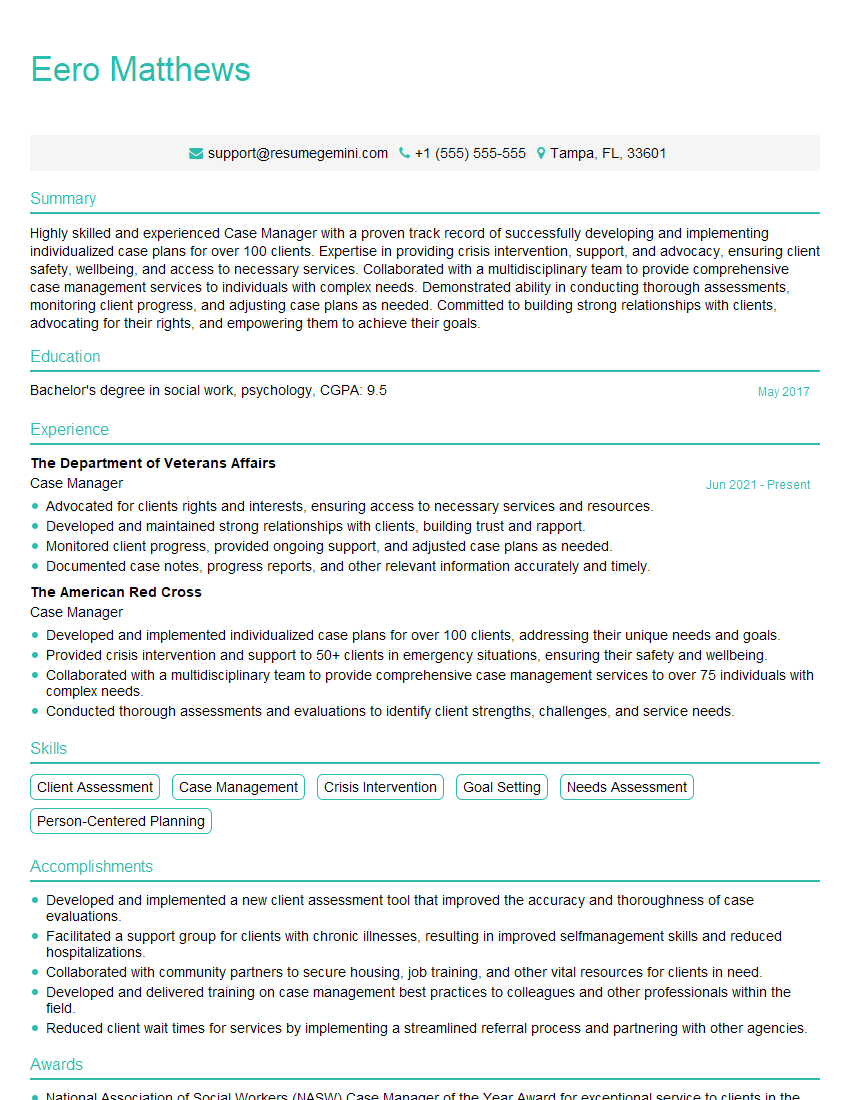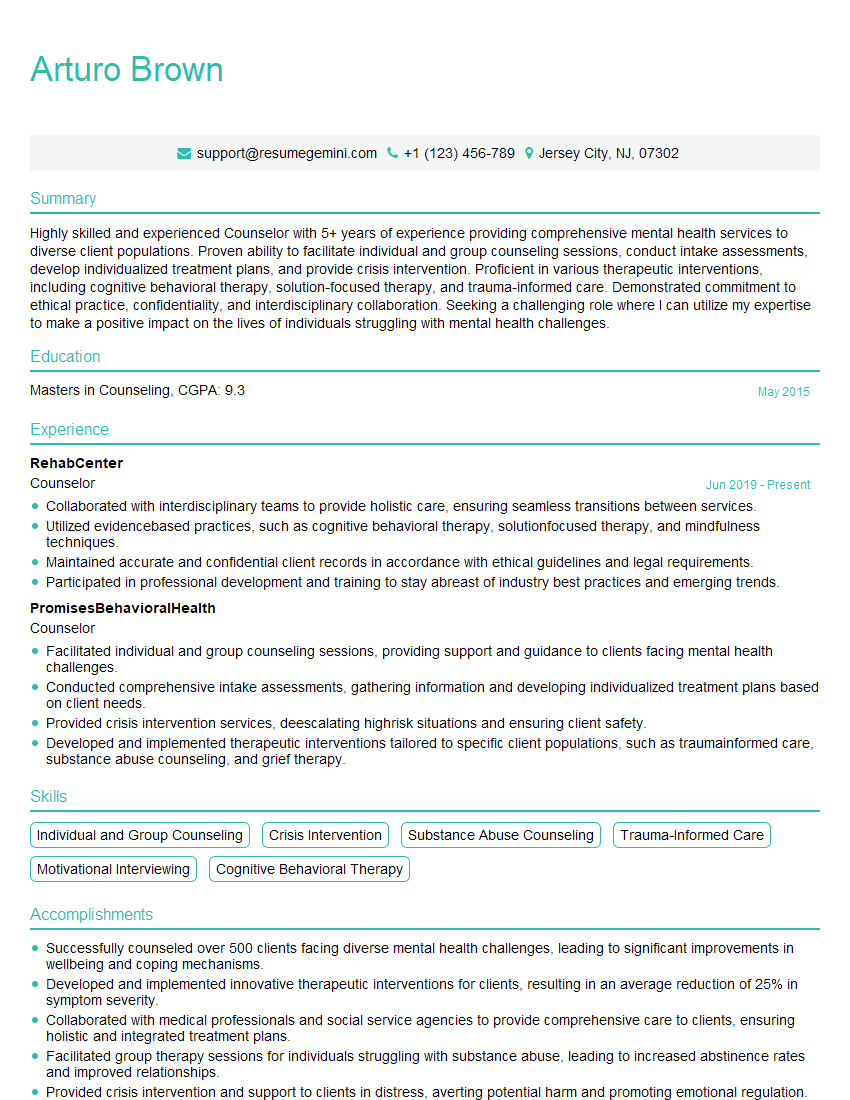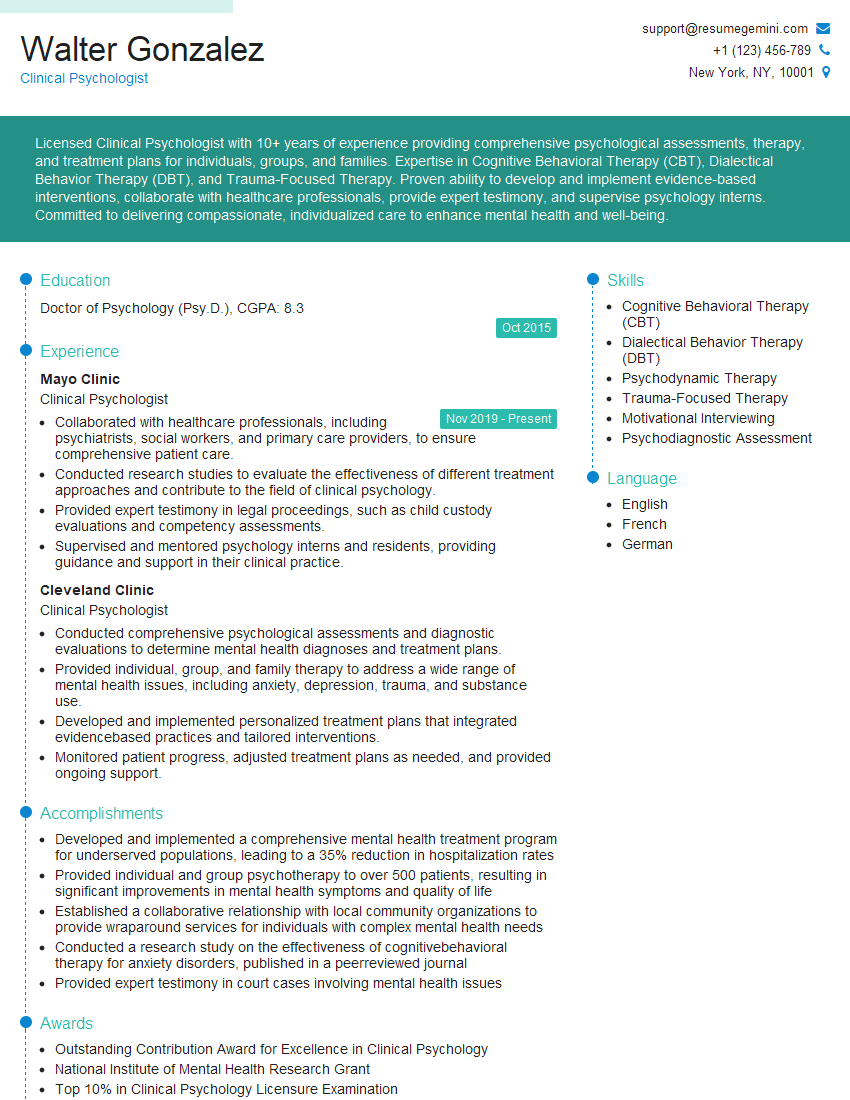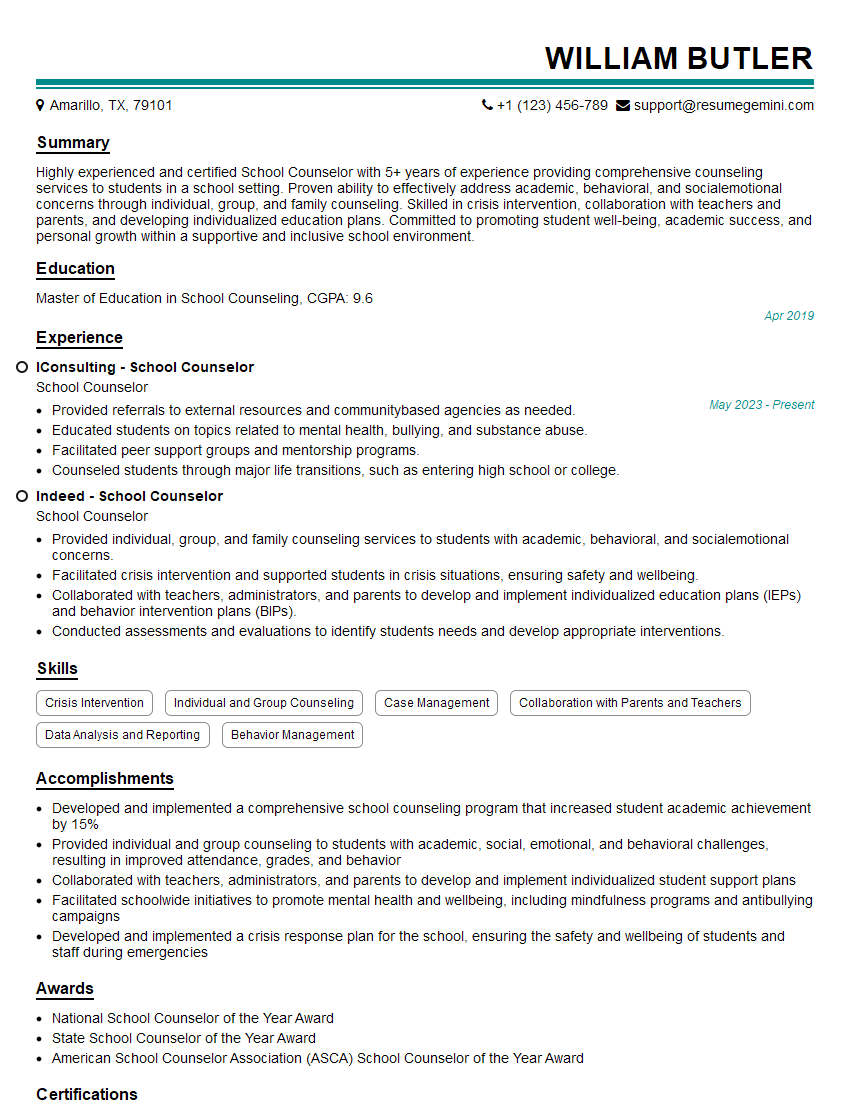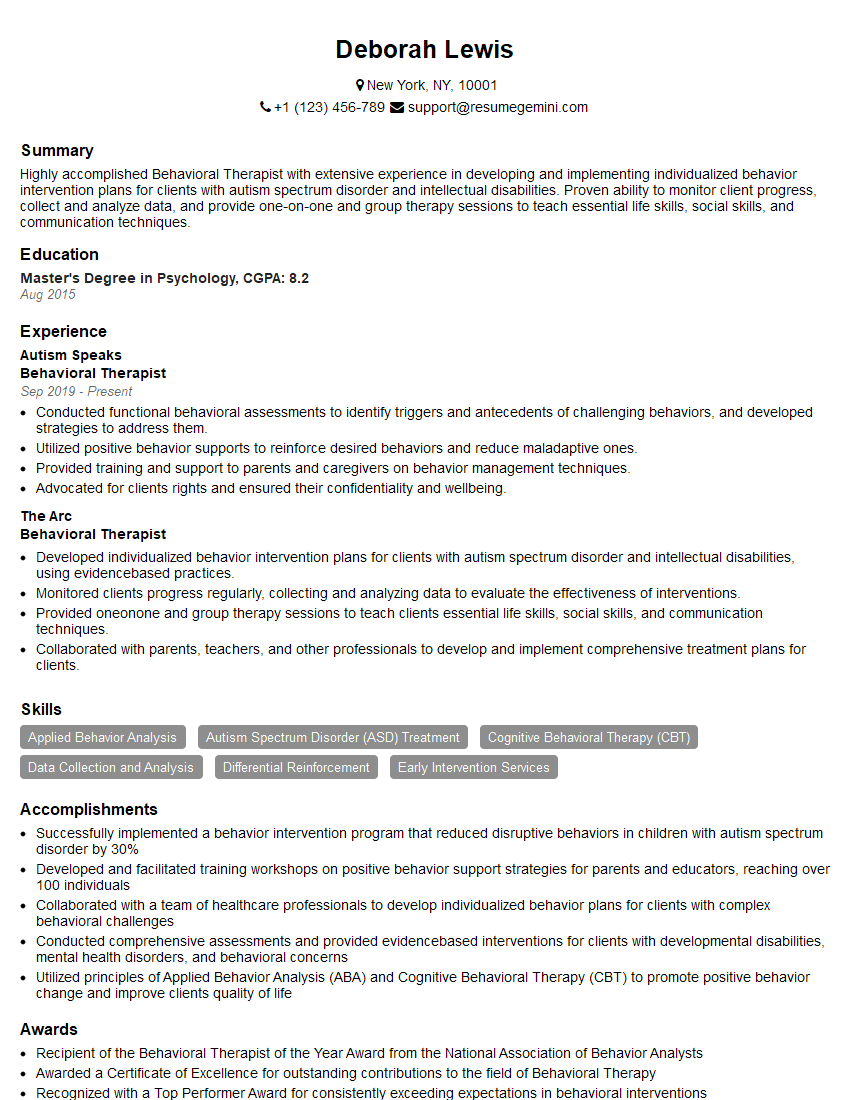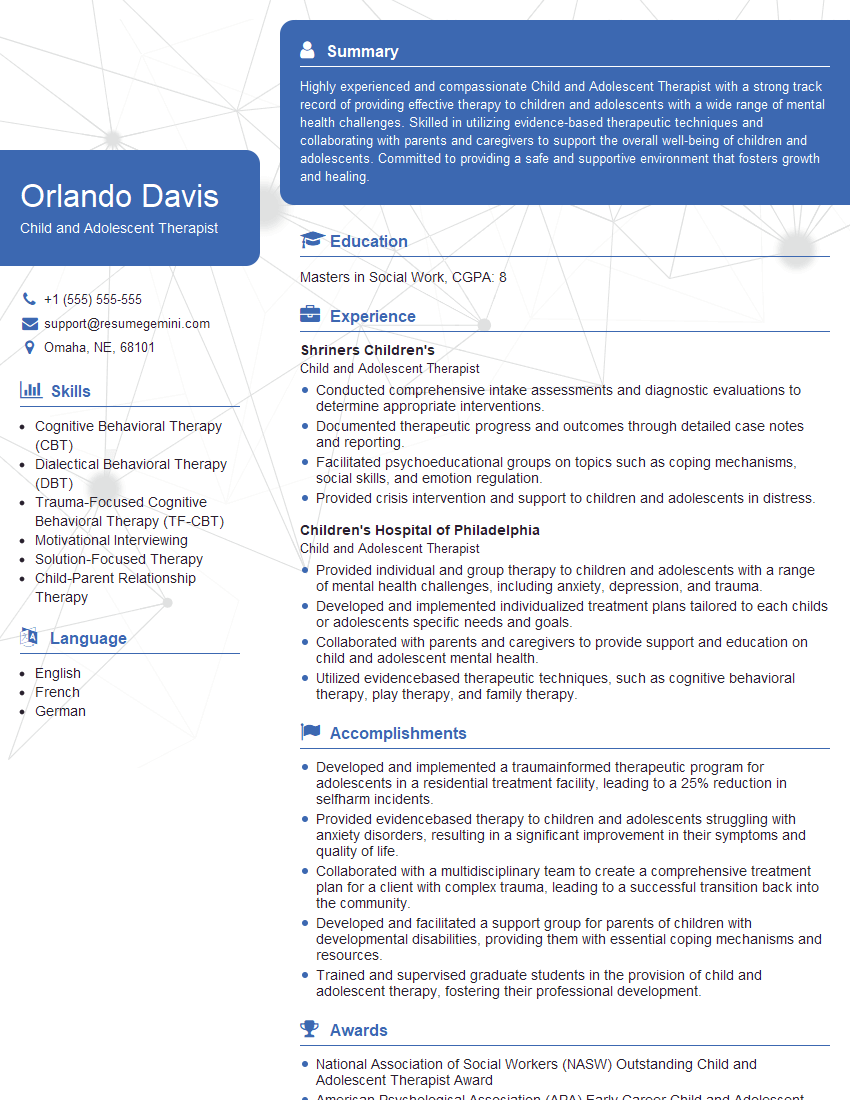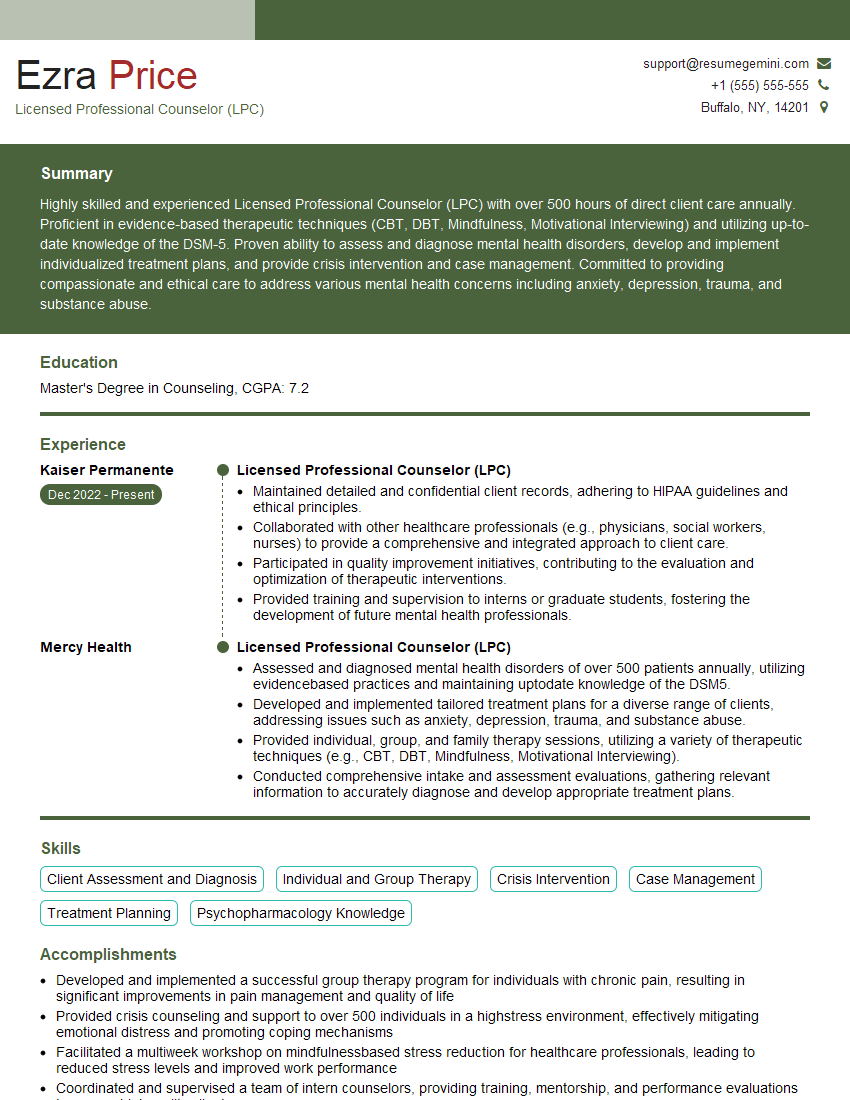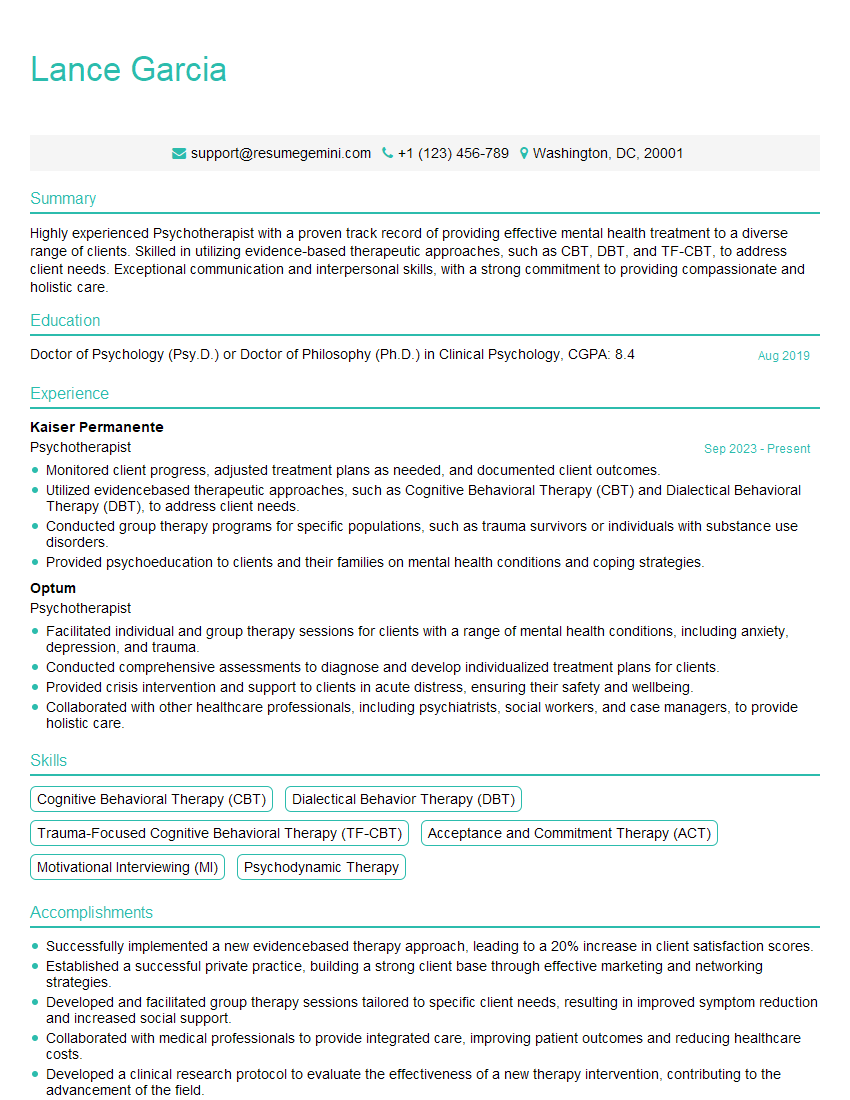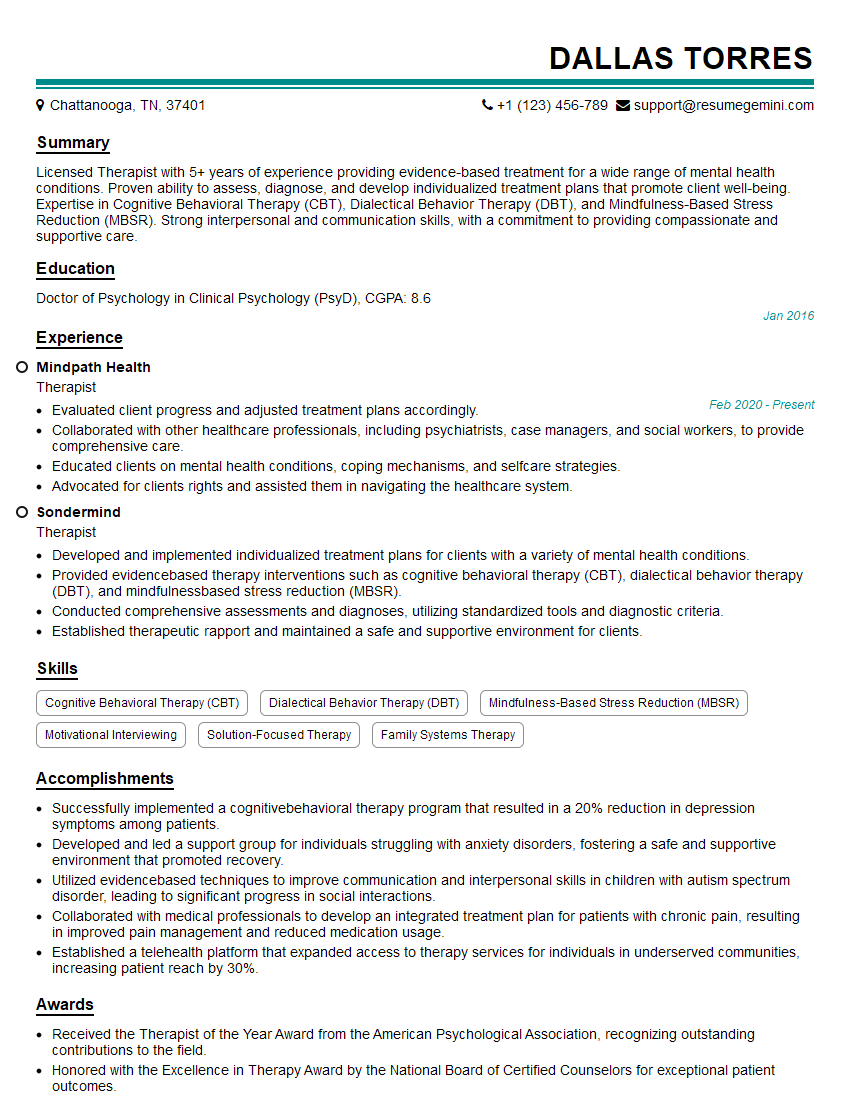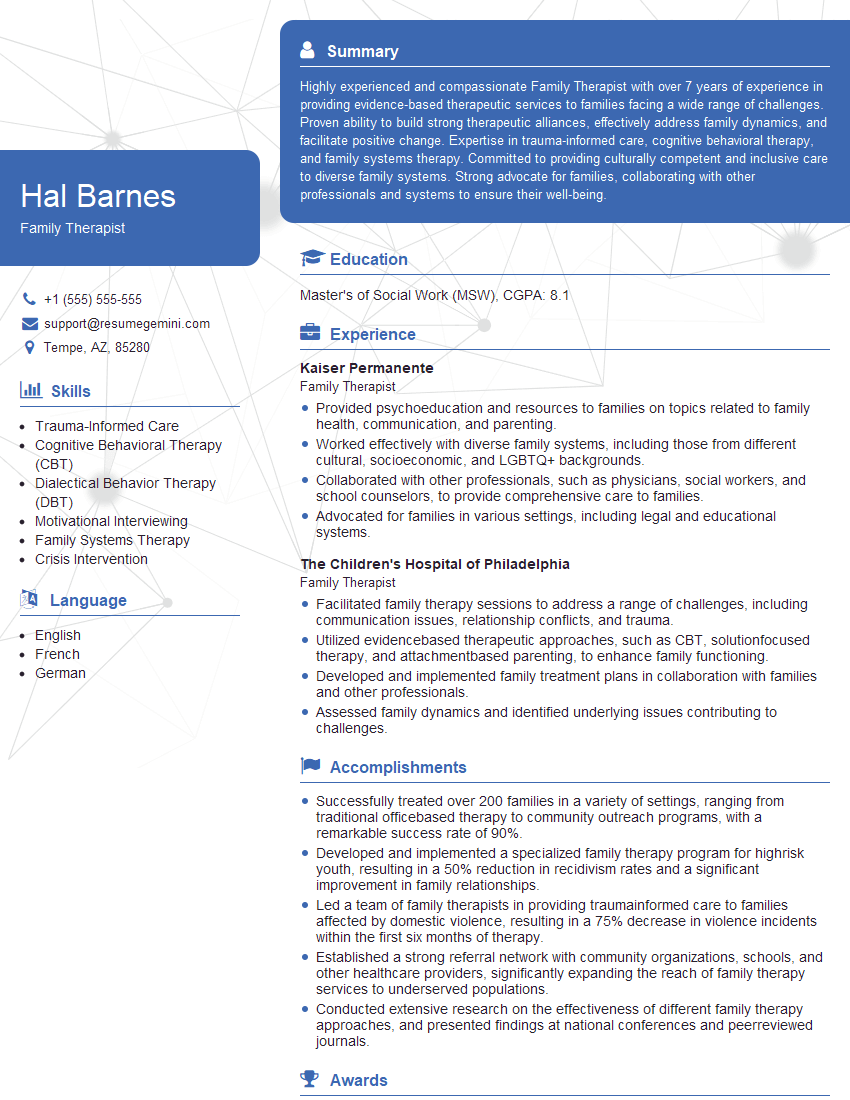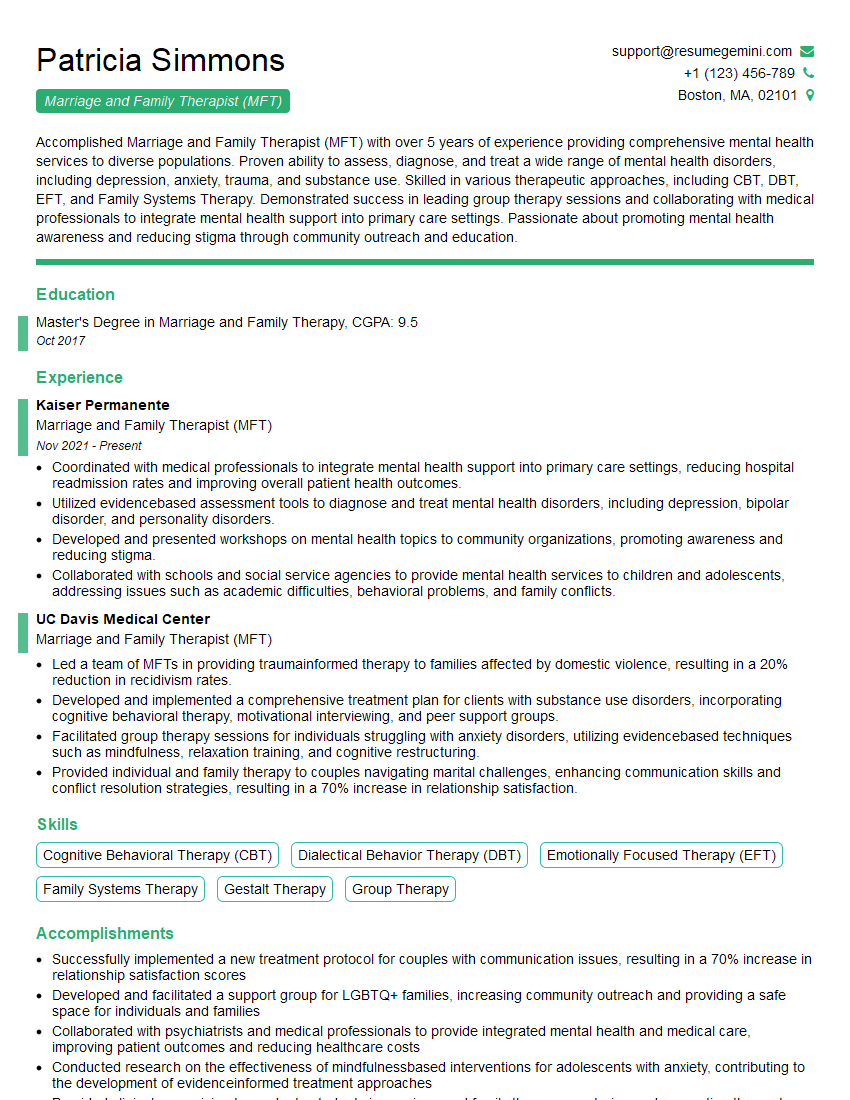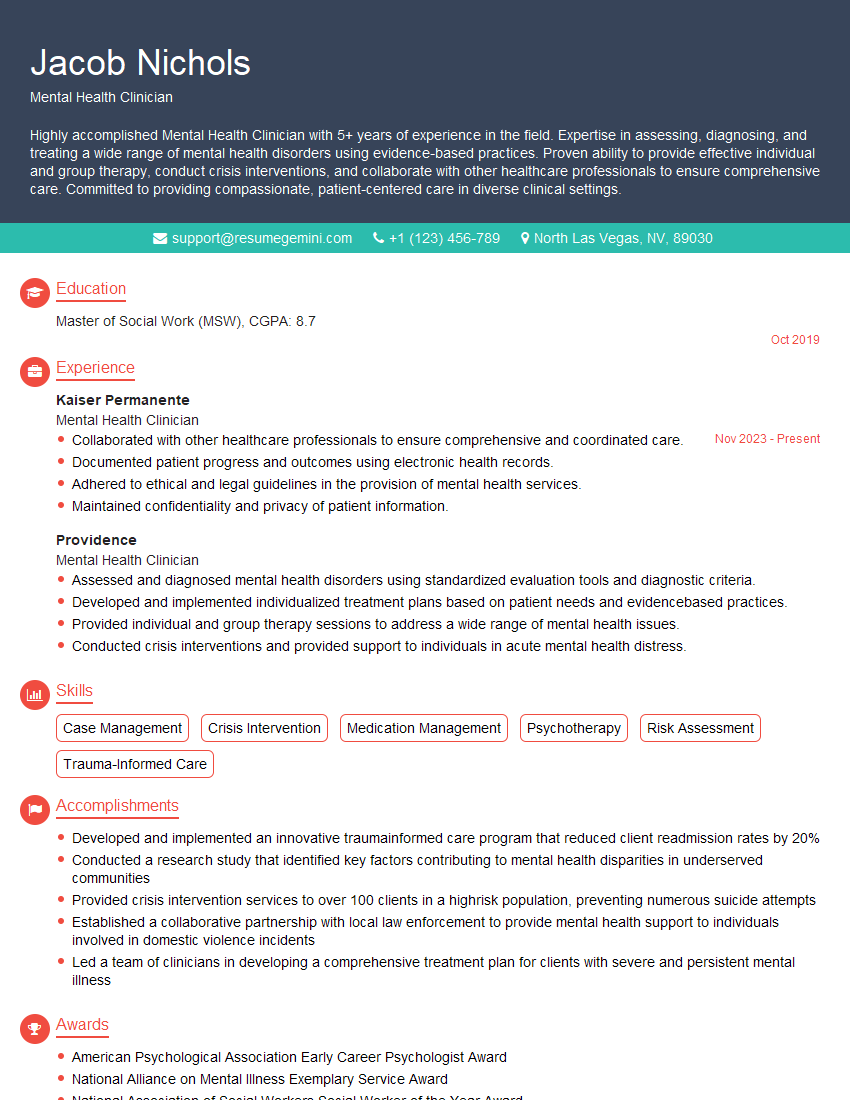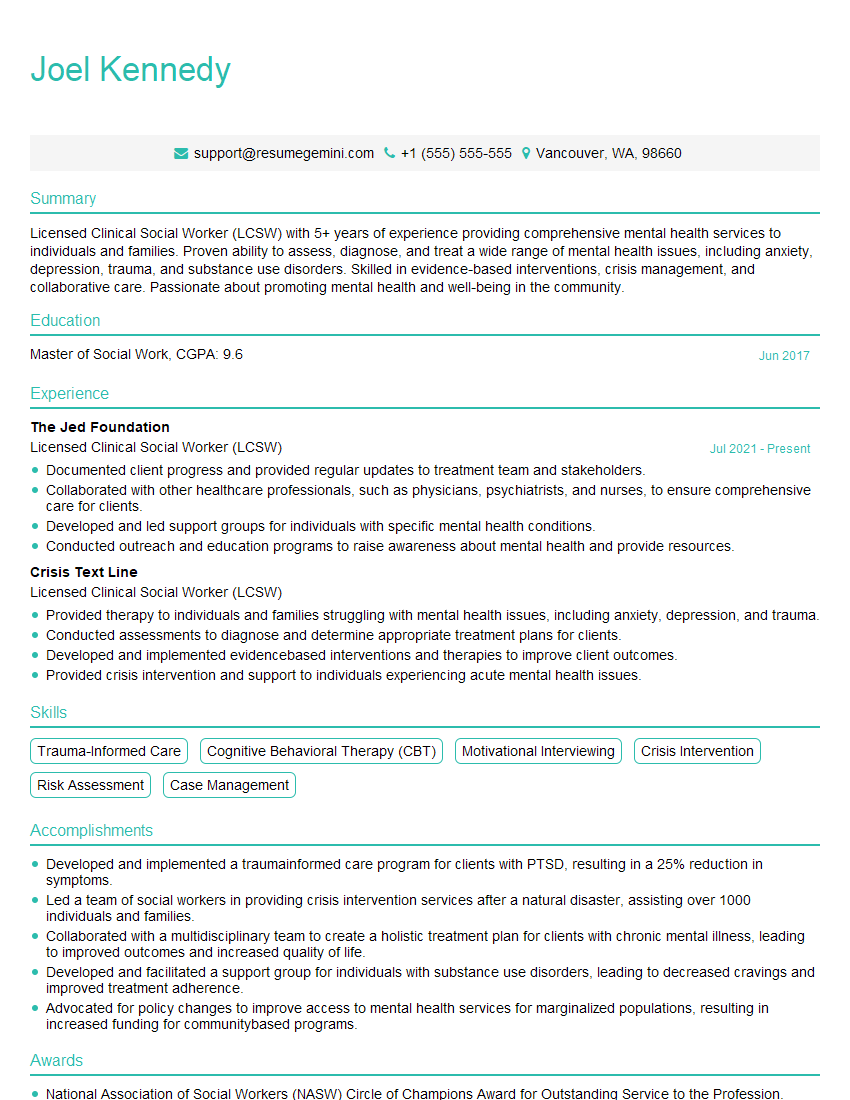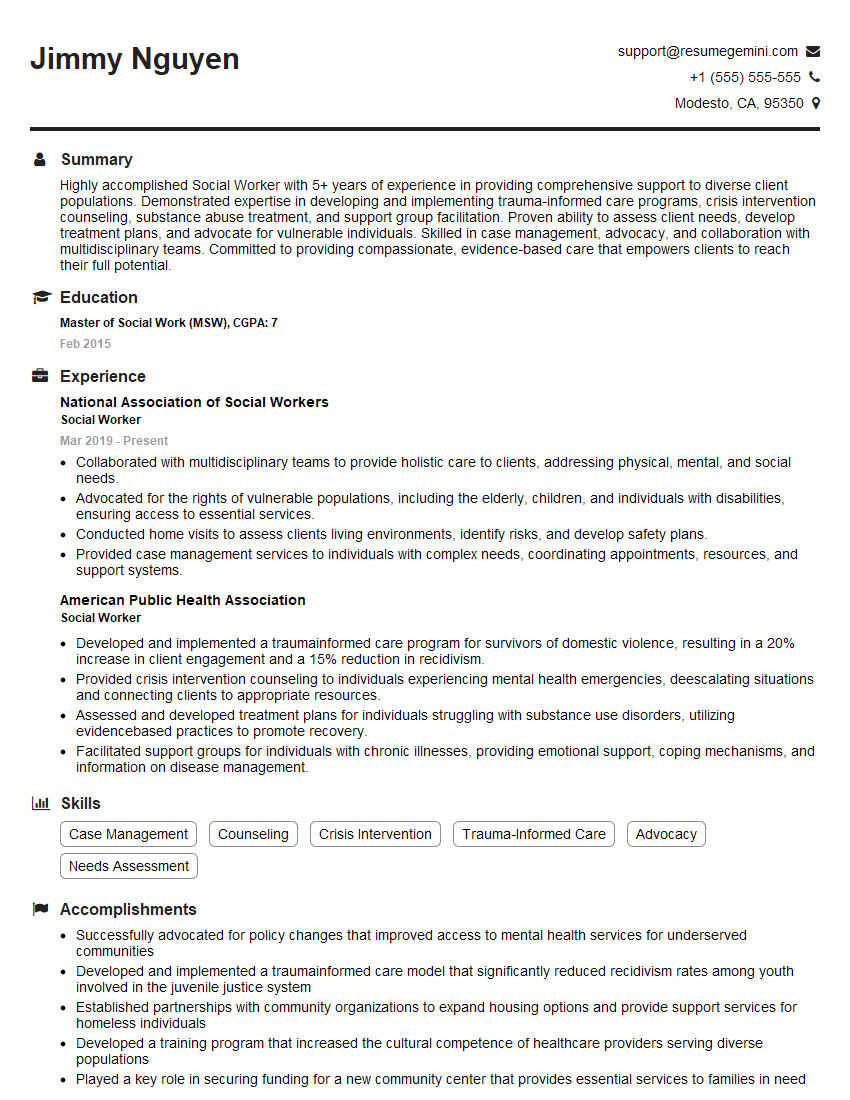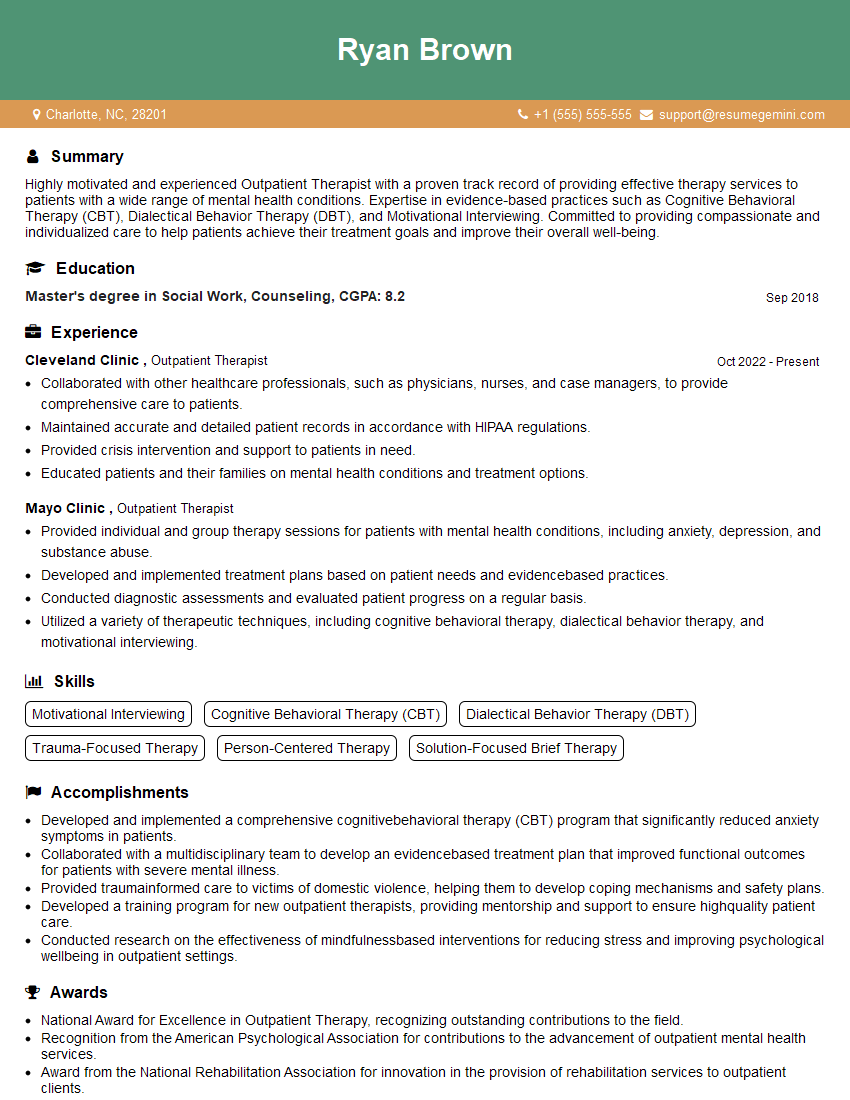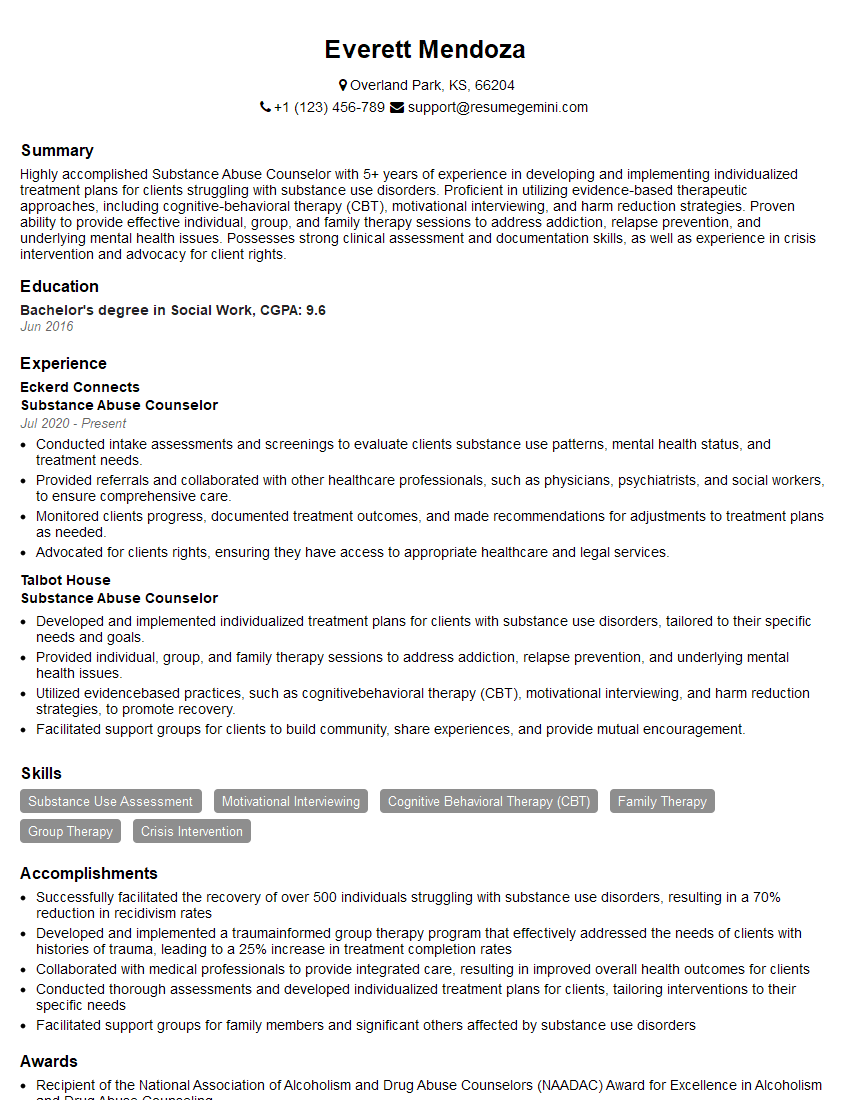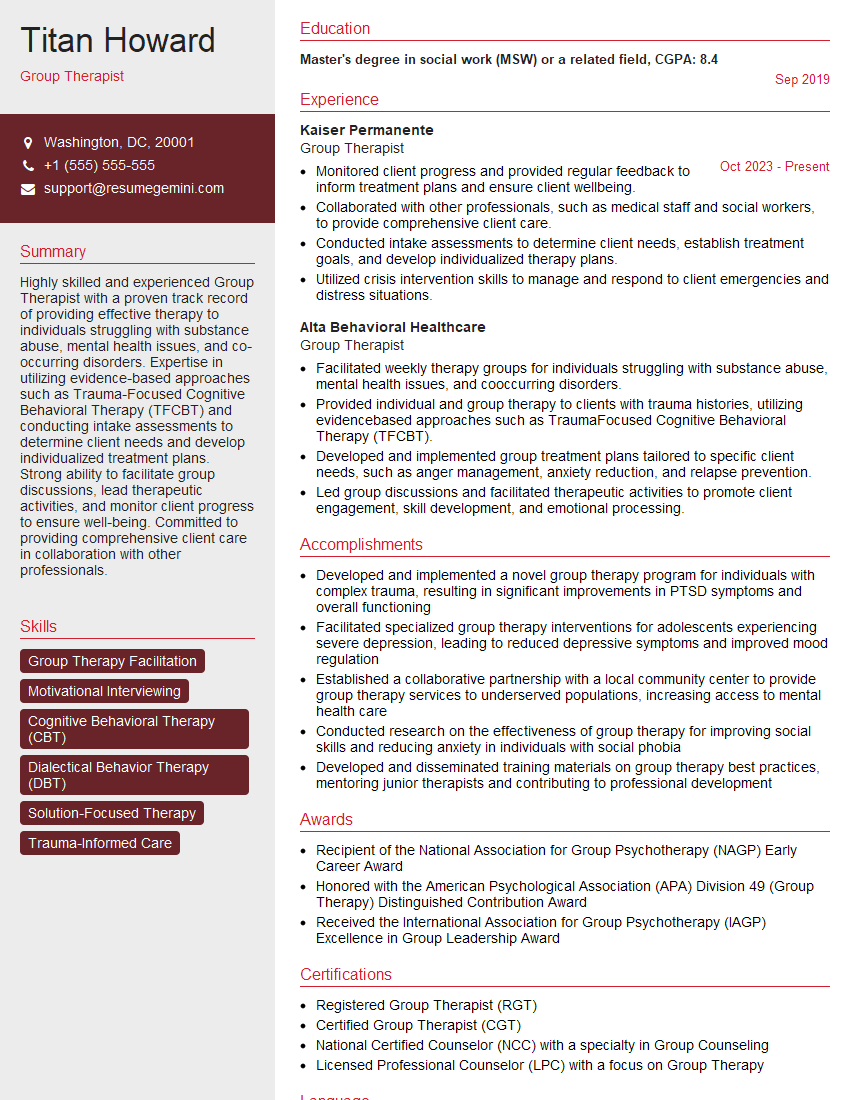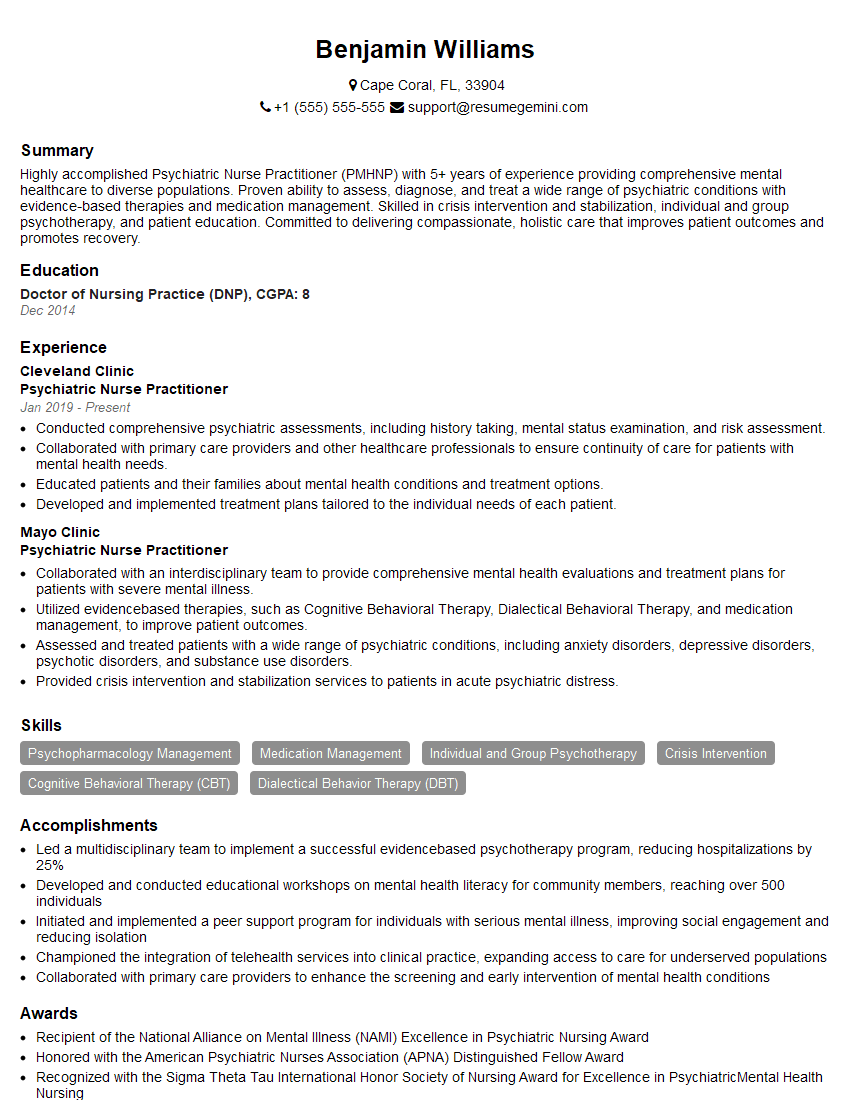Preparation is the key to success in any interview. In this post, we’ll explore crucial Motivational Interviewing and Cognitive-Behavioral Therapy interview questions and equip you with strategies to craft impactful answers. Whether you’re a beginner or a pro, these tips will elevate your preparation.
Questions Asked in Motivational Interviewing and Cognitive-Behavioral Therapy Interview
Q 1. Explain the core principles of Motivational Interviewing.
Motivational Interviewing (MI) is a collaborative, person-centered form of guiding to elicit and strengthen motivation for change. It’s not about persuading or forcing someone to change, but rather helping them discover their own reasons for wanting to change and empowering them to take action. The core principles are:
- Collaboration: MI is a partnership between the therapist and the client, working together to achieve the client’s goals.
- Evocation: The therapist’s role is to draw out the client’s own motivation and resources for change, not to impose their own ideas.
- Autonomy: The client is ultimately in charge of their decisions and choices. The therapist respects the client’s self-determination.
- Compassion: The therapist demonstrates genuine empathy and understanding for the client’s experience.
Imagine a gardener helping a plant grow – they don’t force the plant to grow in a certain way, they provide the right conditions and support the plant’s natural growth. MI is similar; it helps the client’s intrinsic motivation flourish.
Q 2. Describe the four processes of Motivational Interviewing (engaging, focusing, evoking, planning).
The four processes of MI are sequential but iterative, meaning you might revisit earlier stages as needed:
- Engaging: Building rapport and a trusting relationship with the client. This involves active listening, empathy, and showing genuine interest in their perspective. For example, starting with open-ended questions like, “Tell me about why you’re here today.” This sets the stage for a successful therapeutic relationship.
- Focusing: Collaboratively identifying a specific target for change that the client is ready to address. It’s about clarifying goals and prioritizing what feels most important and manageable to the client. If a client mentions multiple issues, you might collaboratively narrow it down to one focused area to start with.
- Evoking: Exploring and strengthening the client’s own motivation for change. This involves using techniques like reflective listening and summarizing to highlight the client’s own arguments for change. This is the heart of MI – helping the client realize their own reasons for wanting a better outcome.
- Planning: Developing a concrete plan for change that the client commits to. This might involve setting SMART goals (Specific, Measurable, Achievable, Relevant, Time-bound) and identifying strategies and resources the client can utilize.
Think of it like a journey – engaging is getting on the road, focusing is deciding the destination, evoking is finding the drive, and planning is choosing the route.
Q 3. How do you use open-ended questions in Motivational Interviewing?
Open-ended questions are fundamental in MI because they encourage the client to elaborate and explore their own thoughts and feelings. They avoid simple “yes” or “no” answers and invite deeper reflection. Examples include:
- “Tell me more about that.”
- “What are your thoughts and feelings about… ?”
- “What concerns you most about… ?”
- “Help me understand…”
For example, instead of asking, “Do you want to quit smoking?”, you might ask, “What are your thoughts and feelings about your smoking habits?” This allows the client to open up more fully and reveals their internal ambivalence, which is crucial for MI.
Q 4. What are the key differences between Motivational Interviewing and Cognitive Behavioral Therapy?
While both MI and CBT aim to improve mental well-being, they differ significantly in their approach:
- Focus: MI focuses primarily on motivation and enhancing the client’s own capacity for change, while CBT focuses on identifying and modifying maladaptive thoughts, feelings, and behaviors.
- Techniques: MI employs techniques like reflective listening, summarizing, and scaling questions to elicit intrinsic motivation, whereas CBT uses techniques like cognitive restructuring, behavioral experiments, and exposure therapy to address specific cognitive and behavioral patterns.
- Directiveness: MI is a more indirect and client-centered approach, empowering the client to lead the process. CBT can be more directive, with the therapist actively guiding the client through specific techniques.
- Goal: MI’s goal is to increase motivation for change and strengthen the client’s commitment to that change. CBT’s goal is to modify underlying cognitive and behavioral patterns maintaining the problem.
Imagine a car needing repair. MI would be like helping the owner decide they want to get it fixed and finding a mechanic. CBT would be like diagnosing the problem and fixing the engine.
Q 5. Explain the cognitive model in CBT.
The cognitive model in CBT posits that our thoughts, feelings, and behaviors are interconnected. Our thoughts influence our emotions and behaviors, and vice versa. A negative thought pattern can trigger negative emotions and lead to maladaptive behaviors. For example, if someone thinks, “I’m going to fail this presentation,” they might feel anxious and avoid preparing for the presentation altogether. The cognitive model aims to identify and modify these unhelpful thinking patterns to create positive changes in emotions and behaviors.
It’s like a triangle where thoughts, feelings, and behaviors influence each other. Changing one element in the triangle can positively affect the others.
Q 6. Describe different CBT techniques (e.g., cognitive restructuring, behavioral activation).
Several CBT techniques are used to address maladaptive thoughts and behaviors:
- Cognitive Restructuring: Identifying and challenging negative or distorted thought patterns and replacing them with more balanced and realistic ones. This might involve identifying cognitive distortions like all-or-nothing thinking or catastrophizing. For example, a client worried about public speaking might be helped to see that feeling anxious doesn’t mean they’ll fail.
- Behavioral Activation: Increasing engagement in pleasurable activities to improve mood and motivation. This is especially helpful for clients experiencing depression or low energy. It might involve scheduling enjoyable activities and gradually increasing participation.
- Exposure Therapy: Gradually exposing the client to feared stimuli or situations to reduce anxiety and avoidance behaviors. This is often used in the treatment of phobias or anxiety disorders. It involves building a hierarchy of fears and gradually confronting them.
- Relaxation Techniques: Teaching the client skills to manage stress and anxiety, such as deep breathing exercises, progressive muscle relaxation, and mindfulness meditation.
These techniques work together to help clients break free from unhelpful thought and behavior cycles.
Q 7. How do you assess a client’s readiness for change using Motivational Interviewing?
Assessing a client’s readiness for change in MI often involves using scales and open-ended questions to explore their ambivalence. The key is to understand their current level of motivation, not to judge or pressure them. Tools and methods include:
- Change Talk vs. Sustain Talk: Identifying statements that reflect a desire, ability, reason, and commitment to change (change talk) versus statements that uphold the status quo (sustain talk).
- Importance and Confidence Rulers: Using numerical scales (0-10) to rate how important change is and how confident they are in their ability to change. This helps visualize the client’s level of motivation and identify discrepancies.
- Open-ended Questions: Exploring their perspectives on the advantages and disadvantages of changing and remaining the same. Questions like “What are some good things about your current situation?” and “What would be some of the challenges in making a change?” can reveal underlying motivations.
- Reflective Listening: Paying close attention to what the client says and reflecting their statements back to them, often using slightly different wording, to deepen understanding and help them clarify their thoughts and feelings.
The goal isn’t to push for a certain score on a scale, but rather to use these tools to understand the client’s perspective and collaboratively build a plan that addresses their level of readiness.
Q 8. How do you handle resistance in Motivational Interviewing?
Resistance in Motivational Interviewing (MI) isn’t viewed as defiance, but rather as a signal that the client isn’t yet ready or willing to change. It’s a natural part of the process. Instead of confronting resistance directly, we use specific techniques to roll with it and guide the client toward self-discovery.
Here’s how I handle it:
- Empathetic Listening and Reflective Listening: I carefully listen to understand the client’s perspective, reflecting their concerns and ambivalence back to them using phrases like, “So, it sounds like you’re feeling uncertain about making a change at this time.” This demonstrates acceptance and avoids confrontation.
- Avoiding Argumentation: I resist the urge to argue or persuade the client. Instead, I focus on understanding their reasons for resistance. I might ask open-ended questions like, “Can you tell me more about why you feel that way?” or “What are the benefits of maintaining the status quo?”
- Developing Discrepancy: I help the client identify discrepancies between their values and their current behavior. For example, someone who values health might be resistant to exercise, and I would help them explore this conflict.
- Supporting Self-Efficacy: I emphasize the client’s capacity for change, highlighting past successes and focusing on their strengths. Small, achievable steps build confidence and momentum.
- Reframing Resistance: I view resistance as an opportunity to gain a deeper understanding of the client’s perspective and tailor my approach accordingly. This means constantly adjusting my approach to meet the client where they are.
For example, if a client resists quitting smoking, I wouldn’t lecture them on the dangers. I’d explore their concerns: what are the pros and cons of quitting in *their* mind? By understanding their perspective, I can help them find the motivation to change from within.
Q 9. What are the limitations of Motivational Interviewing?
While MI is a highly effective approach, it does have limitations. It’s not a one-size-fits-all solution and its effectiveness depends on several factors:
- Client Motivation: MI is most effective with clients who possess at least some degree of intrinsic motivation to change. Clients who are completely resistant or lack insight into their problems might not benefit as much.
- Severity of Problem: For individuals with severe mental illness or complex substance use disorders, MI might need to be integrated with other therapies to address the underlying issues comprehensively. It’s not a stand-alone treatment for all conditions.
- Therapist Skills: The effectiveness of MI hinges on the therapist’s ability to utilize the core MI principles skillfully. Proper training and ongoing supervision are crucial.
- Time Constraints: While efficient, MI may not be the most appropriate approach when rapid change is needed or when there are significant time constraints.
- Client’s Readiness: MI works best when the client is at least somewhat ready to consider change. If they are completely unwilling to even discuss change, MI may not be effective.
Essentially, MI is best suited for guiding individuals through the process of exploring their ambivalence and making their own decisions about change, but it’s not a magic bullet for every situation.
Q 10. What are the limitations of Cognitive Behavioral Therapy?
Cognitive Behavioral Therapy (CBT) is a powerful therapy, but it also has its limitations. These limitations include:
- Complexity of Issues: CBT may not be sufficient for individuals struggling with severe personality disorders, deep-seated trauma, or significant relationship problems that require more intensive exploration. It is better suited to more targeted problems.
- Client’s Engagement and Ability: CBT requires active participation and self-monitoring from the client. Individuals with limited cognitive capacity, severe mental illness, or low motivation may struggle to engage fully in the therapeutic process.
- Focus on the Present: While CBT addresses present-day issues and behaviors, it might not delve as deeply into past experiences or underlying emotional patterns as other therapies.
- Time Commitment: Effective CBT often requires a significant time investment from both the therapist and the client. This may not be feasible for everyone.
- Potential for Oversimplification: CBT’s focus on cognitive restructuring can sometimes oversimplify complex emotional experiences. The nuances of human emotion may not always be easily addressed through cognitive techniques alone.
Despite these limitations, CBT remains a highly effective approach for a wide range of conditions, and when used appropriately and in combination with other techniques, can overcome many of these limitations.
Q 11. How do you adapt CBT techniques for different client populations (e.g., children, adults, couples)?
Adapting CBT techniques for different client populations requires tailoring the approach to their developmental stage, cognitive abilities, and communication styles. Here are some examples:
- Children: CBT for children often involves play therapy, storytelling, and visual aids. Cognitive restructuring is simplified, focusing on identifying feelings and behaviors through games and activities. Parents are often involved in the treatment process.
- Adults: Adult CBT utilizes more sophisticated cognitive restructuring techniques, such as identifying and challenging negative automatic thoughts. The focus is on self-monitoring, goal setting, and problem-solving skills.
- Couples: CBT for couples focuses on communication skills, conflict resolution, and identifying negative interaction patterns. Techniques such as behavioral experiments and collaborative problem-solving are used to improve relational dynamics.
The core principles of CBT remain consistent across populations (identifying and modifying maladaptive thoughts and behaviors), but the methods used to achieve those goals are adapted to suit the specific needs and capabilities of each client group. For example, while an adult might complete written thought records, a child might use drawings to express their thoughts and feelings.
Q 12. Describe a situation where you successfully used Motivational Interviewing to help a client.
I worked with a client, Sarah, who was struggling with binge eating. She expressed a desire to lose weight but consistently felt overwhelmed and lacked self-efficacy. Using MI, I began by empathetically listening to her struggles, reflecting her feelings of frustration and self-criticism. I avoided directly telling her what to do and instead asked open-ended questions like, “What are some of the things that make you feel like you need to binge eat?” and “What would a healthier relationship with food look like to you?”
Through these conversations, we identified discrepancies between her stated desire for healthier eating and her current behaviors. I helped her explore the advantages and disadvantages of both continuing her current behavior and making a change. By focusing on her own values and goals, rather than dictating a solution, she gradually developed a stronger sense of self-efficacy and began to explore strategies for making gradual, sustainable changes.
Q 13. Describe a situation where you successfully used CBT to help a client.
A client, Mark, suffered from severe social anxiety. Using CBT, we collaborated on identifying his negative automatic thoughts (NATs) related to social situations. For example, when faced with meeting new people, he’d think, “They’ll think I’m boring and awkward.” We then challenged these thoughts using cognitive restructuring techniques: exploring the evidence for and against his NATs, identifying alternative interpretations, and testing out his assumptions through behavioral experiments.
Together, we created a hierarchy of feared social situations, starting with low-anxiety scenarios and gradually progressing to higher ones. Mark systematically exposed himself to these situations, utilizing relaxation techniques to manage his anxiety. Through this process, he gradually challenged his negative beliefs, building confidence and reducing his social anxiety symptoms. Consistent tracking and reinforcement of progress solidified the gains made.
Q 14. How do you measure the effectiveness of your interventions in MI and CBT?
Measuring the effectiveness of MI and CBT interventions involves a multi-faceted approach. We don’t rely on a single measure, but rather integrate various methods to get a comprehensive picture of client progress:
- Self-Report Measures: Standardized questionnaires and scales are used to assess changes in symptoms, mood, and overall functioning. Examples include the Beck Depression Inventory (BDI) for depression, the Generalized Anxiety Disorder 7-item scale (GAD-7) for anxiety and the Client Satisfaction Questionnaire (CSQ).
- Behavioral Observation: In CBT, direct observation of client behavior during therapy sessions and in real-life situations can provide valuable insights into the effectiveness of interventions. In MI, we observe shifts in the client’s self-expression and readiness for change.
- Goal Attainment Scaling (GAS): This approach involves collaboratively setting specific, measurable, achievable, relevant, and time-bound (SMART) goals with the client at the start of therapy. Progress towards these goals is then regularly assessed.
- Clinical Interviews: Regular clinical interviews allow for a comprehensive assessment of the client’s progress, identifying challenges, and adjusting the treatment plan as needed.
The choice of assessment tools depends on the specific client and the presenting problem. It is crucial to track progress over time to evaluate the long-term impact of the interventions.
Q 15. What ethical considerations are important when using MI and CBT?
Ethical considerations in using Motivational Interviewing (MI) and Cognitive Behavioral Therapy (CBT) are paramount. They center around client autonomy, beneficence, non-maleficence, justice, and fidelity.
- Autonomy: Clients must be fully informed and empowered to make their own decisions about their treatment. This includes respecting their right to refuse treatment or to choose a different approach. For example, in MI, we guide, not direct; in CBT, we collaborate on goal setting, never imposing our own views.
- Beneficence: We are obligated to act in the best interests of our clients. This means using evidence-based techniques, staying updated in our training, and continually assessing if our approach remains effective. If it’s not, we need to adapt or refer.
- Non-maleficence: We must avoid causing harm. This involves being mindful of potential triggers or negative consequences of our interventions, and ensuring that our interventions are appropriately tailored to the client’s situation and capabilities.
- Justice: We must ensure fair and equitable access to services. This means addressing potential biases and being aware of systemic inequalities that may impact our clients’ access to and outcomes from care.
- Fidelity: We must maintain trust and act with integrity. This includes maintaining confidentiality, setting clear boundaries, and being accountable for our actions.
A breach of ethics might involve pressuring a client into a treatment plan they’re not ready for (violating autonomy) or failing to recognize and address countertransference (potentially leading to harm).
Career Expert Tips:
- Ace those interviews! Prepare effectively by reviewing the Top 50 Most Common Interview Questions on ResumeGemini.
- Navigate your job search with confidence! Explore a wide range of Career Tips on ResumeGemini. Learn about common challenges and recommendations to overcome them.
- Craft the perfect resume! Master the Art of Resume Writing with ResumeGemini’s guide. Showcase your unique qualifications and achievements effectively.
- Don’t miss out on holiday savings! Build your dream resume with ResumeGemini’s ATS optimized templates.
Q 16. How do you integrate MI and CBT in your therapeutic approach?
I integrate MI and CBT in a synergistic way. MI’s strengths lie in building motivation and addressing ambivalence, while CBT excels in identifying and modifying maladaptive thoughts and behaviors. Imagine a client struggling with anxiety around public speaking.
- MI Phase: I would first use MI techniques like open-ended questions (‘Tell me more about your experience with public speaking’) and reflective listening to understand their current perspective, explore their ambivalence about change, and strengthen their intrinsic motivation to improve.
- CBT Phase: Once motivation is established, I would move into CBT strategies. This could involve identifying and challenging anxious thoughts (‘Everyone will notice I’m nervous’), developing coping skills (e.g., relaxation techniques, positive self-talk), and gradually exposing the client to public speaking situations through behavioral experiments.
The integration is fluid. Throughout the process, I continuously assess the client’s motivation and adapt my approach accordingly, using MI to address resistance or wavering motivation that might arise during the CBT process. It’s a collaborative journey, with both modalities supporting the client’s progress.
Q 17. How do you build rapport and trust with clients?
Building rapport and trust is foundational. I prioritize creating a safe and non-judgmental space where clients feel comfortable being vulnerable.
- Active Listening: I pay close attention to both verbal and nonverbal cues, reflecting back what I hear to ensure understanding (‘So, it sounds like you’re feeling overwhelmed’).
- Empathy: I strive to understand the client’s perspective from their frame of reference, showing genuine care and validating their feelings.
- Collaboration: The therapeutic process is a partnership. I work collaboratively with clients to set goals and develop a treatment plan that aligns with their values and preferences.
- Self-Disclosure (appropriately): Sometimes sharing relevant, brief, and non-intrusive personal anecdotes can build connection, as long as the focus stays on the client’s needs.
For instance, if a client expresses shame, I might acknowledge the difficulty of sharing such feelings, building a sense of understanding and fostering trust. The key is authenticity and respect for the client’s boundaries.
Q 18. How do you handle difficult or challenging clients?
Handling challenging clients requires flexibility, self-awareness, and a strong ethical compass.
- Self-Reflection: I regularly examine my own reactions and biases. If I’m feeling frustrated or triggered, I might need supervision or consultation to ensure I’m responding effectively and ethically.
- Setting Boundaries: Clear, consistent boundaries are vital. This might involve addressing disrespectful behavior, clarifying expectations, or referring the client if necessary.
- Collaboration and Reframing: I strive to understand the client’s perspective, even if I disagree. I might reframe the situation to find common ground, focusing on what the client *wants* to achieve, not just on what they’re *doing wrong*.
- Safety Planning: If a client is at risk of harming themselves or others, immediate safety planning is paramount, which might involve hospitalisation or involving relevant authorities.
Example: A client consistently misses appointments. Instead of labeling them as ‘unmotivated,’ I would explore the reasons behind this behavior using MI, perhaps uncovering underlying anxiety or logistical barriers.
Q 19. How do you maintain your own mental health and wellbeing as a therapist?
Maintaining my own well-being is non-negotiable. Burnout is a real risk in this profession.
- Self-Care Practices: I prioritize regular exercise, healthy eating, sufficient sleep, and engaging in activities I enjoy outside of work.
- Supervision: Regular supervision provides a safe space to process challenging cases, receive feedback, and maintain ethical practice.
- Boundaries: I am diligent about setting and maintaining professional boundaries to prevent blurring lines between work and personal life. This means sticking to appointment times and not engaging in extensive personal communication outside of sessions.
- Mindfulness and Self-Compassion: I practice mindfulness techniques to manage stress and cultivate self-compassion, recognizing that I’m not perfect and that setbacks are a normal part of the therapeutic process.
Taking care of myself isn’t selfish; it’s essential for providing effective and ethical care to my clients.
Q 20. What are your strengths and weaknesses as a therapist?
My strengths include strong empathy, active listening skills, and a genuine desire to help others. I’m adaptable and comfortable integrating different therapeutic approaches to best meet clients’ needs. I’m also proactive in seeking supervision to refine my skills and address potential blind spots.
My weaknesses include a tendency to over-invest emotionally in clients (which I mitigate through supervision and self-care). I’m also continuously working to improve my skills in managing clients with particularly complex or severe presentations, such as those involving trauma or severe personality disorders. I actively seek further training and consultation in these areas.
Q 21. What is your experience with [specific mental health condition]?
Please specify the mental health condition.
Q 22. Describe your preferred therapeutic style.
My preferred therapeutic style integrates the strengths of Motivational Interviewing (MI) and Cognitive Behavioral Therapy (CBT). I believe this collaborative approach is highly effective for a wide range of clients. MI focuses on eliciting intrinsic motivation for change by exploring and resolving ambivalence. CBT, on the other hand, targets maladaptive thoughts and behaviors that contribute to difficulties. In practice, I begin by building a strong therapeutic alliance using MI’s empathetic and supportive approach. I then collaboratively explore the client’s concerns, using MI’s guiding principles of expressing empathy, developing discrepancy, rolling with resistance, and supporting self-efficacy. Once a clear direction for change emerges, we collaboratively identify specific cognitive and behavioral patterns maintaining the issue. We then work together to develop and implement personalized strategies using CBT techniques like cognitive restructuring, behavioral activation, and exposure therapy. For example, a client struggling with procrastination might initially express ambivalence about changing. Through MI, we would explore their values and goals, identifying discrepancies between their current behavior and their desired life. Then, using CBT, we’d pinpoint the negative automatic thoughts fueling their procrastination (e.g., ‘I’ll never finish this’) and develop coping mechanisms (e.g., breaking tasks into smaller steps, self-reward systems). This integrated approach allows for a flexible and tailored treatment plan, maximizing client engagement and outcome.
Q 23. How do you manage client confidentiality?
Client confidentiality is paramount. I adhere strictly to all relevant ethical guidelines and legal regulations regarding the protection of Protected Health Information (PHI). This includes following HIPAA regulations (in the US) or equivalent regulations in other jurisdictions. I only disclose client information when legally required, such as in cases of mandated reporting (e.g., child abuse, threats of harm to self or others). Even then, disclosure is limited to the minimum necessary information. I obtain informed consent from clients before sharing any information with other professionals involved in their care. My practice includes secure storage of all client records, both physical and electronic, using password protection and encryption where appropriate. I emphasize the importance of confidentiality during the initial session and regularly reinforce it throughout therapy. The importance of safeguarding client privacy is consistently at the forefront of my professional practice.
Q 24. How do you document client sessions?
I maintain thorough and accurate session documentation in accordance with best practices and legal requirements. My documentation follows a consistent format, generally including the date, time, and duration of the session; a summary of the client’s presentation; key discussion points; identified goals and progress towards them; treatment plan modifications; and any significant events or concerns. I use clear and concise language, avoiding clinical jargon whenever possible. Specific techniques employed, including MI and CBT strategies used, are documented, along with the client’s response. For example, if we used cognitive restructuring to challenge negative thoughts related to social anxiety, I would note the specific thoughts targeted and the alternative, more adaptive thoughts collaboratively generated. This detailed documentation ensures continuity of care, facilitates effective collaboration with other professionals, and provides a record of the therapeutic process for legal and administrative purposes. It’s essential for both accountability and quality of care.
Q 25. What is your approach to crisis intervention?
My approach to crisis intervention is guided by the principles of safety and stabilization. If a client presents in crisis, my immediate priority is to assess the level of risk to themselves or others. This assessment involves careful questioning to understand the nature and intensity of their distress, considering factors such as suicidal or homicidal ideation, self-harm behaviors, and access to means. If there’s an immediate danger, I immediately contact emergency services (911 or local equivalent) or the client’s designated support system. Prioritizing safety and ensuring the client’s well-being are my top priorities. Following stabilization, the focus shifts towards supporting coping mechanisms, connecting the client with needed resources, such as crisis hotlines, mobile crisis teams, or hospitalization if necessary. The collaborative aspect of MI, by encouraging self-efficacy, and the targeted interventions of CBT, such as grounding techniques and distress tolerance skills, are vital for helping the client regain a sense of control and stability. Post-crisis, the focus shifts toward developing a relapse prevention plan, reinforcing progress, and ensuring continued support.
Q 26. How do you collaborate with other members of a treatment team?
Collaboration is essential in effective treatment. I believe in a team-based approach and actively participate in communication with other members of a treatment team, including psychiatrists, case managers, and other therapists. I regularly attend team meetings and actively participate in case conferences, sharing relevant information, and seeking input and support from my colleagues. I maintain clear and concise communication, providing timely updates on the client’s progress, treatment challenges, and any changes in the treatment plan. I utilize secure electronic communication methods to share sensitive client information, ensuring confidentiality is maintained. For example, if a client is also receiving medication management, I would regularly communicate with their psychiatrist about their progress in therapy and any relevant behavioral or emotional changes to optimize their overall care. This integrated approach ensures that the client receives comprehensive and coordinated care.
Q 27. How do you stay up-to-date with current best practices in MI and CBT?
Staying current with best practices in MI and CBT is ongoing and requires a multifaceted approach. I regularly attend professional conferences, workshops, and seminars on MI and CBT techniques, emerging research, and related therapeutic approaches. I actively pursue continuing education units (CEUs) to maintain my professional licenses and demonstrate commitment to ongoing professional development. I subscribe to professional journals and regularly read peer-reviewed articles on MI and CBT. I actively participate in professional organizations focused on MI and CBT, attending conferences and networking with colleagues in the field. I engage in peer supervision or consultation regularly, discussing cases with other experienced clinicians to refine my approaches and stay abreast of novel developments. This continuous learning ensures I provide the most effective and evidence-based care possible.
Q 28. Describe your experience with electronic health records (EHRs).
I have extensive experience using electronic health records (EHRs). I am proficient in utilizing various EHR systems for documenting client sessions, managing client information, generating reports, and maintaining compliance with regulatory requirements. My experience includes using EHRs for scheduling appointments, communicating with clients and other healthcare professionals, and accessing clinical data from various sources. I understand the importance of data security and privacy within the EHR system and adhere strictly to all protocols to protect client confidentiality. I am familiar with using EHRs to track key performance indicators (KPIs) related to treatment outcomes and can utilize this data for evaluating the effectiveness of interventions and informing future treatment planning. I consider myself comfortable and proficient in navigating the use of EHR systems in modern clinical practice.
Key Topics to Learn for Motivational Interviewing and Cognitive-Behavioral Therapy Interview
- Motivational Interviewing (MI): Understanding the core principles of MI: empathy, discrepancy, rolling with resistance, supporting self-efficacy. Explore the stages of change model and its practical application in therapy sessions.
- MI Techniques: Mastering open-ended questions, affirmations, reflective listening, and summarizing. Practice applying these techniques in hypothetical client scenarios to demonstrate your proficiency.
- Cognitive-Behavioral Therapy (CBT): Grasping the fundamental concepts of CBT: cognitive distortions, behavioral activation, and the cognitive triad. Understand how thoughts, feelings, and behaviors interact.
- CBT Techniques: Familiarizing yourself with techniques like cognitive restructuring, behavioral experiments, and exposure therapy. Be prepared to discuss their applications and limitations.
- Integrating MI and CBT: Exploring the synergistic potential of combining MI and CBT approaches. Consider how you might use MI to enhance client motivation for CBT techniques.
- Ethical Considerations: Understanding the ethical implications of both MI and CBT, including informed consent, confidentiality, and cultural sensitivity. Be ready to discuss ethical dilemmas and your approach to resolving them.
- Case Conceptualization: Developing a comprehensive understanding of how to formulate a case conceptualization using both MI and CBT frameworks. Practice integrating client information to create a treatment plan.
- Treatment Planning and Goal Setting: Demonstrating your ability to collaboratively develop SMART goals with clients and create tailored treatment plans using MI and CBT principles.
Next Steps
Mastering Motivational Interviewing and Cognitive-Behavioral Therapy is crucial for career advancement in mental health. These skills are highly sought after, opening doors to diverse and rewarding opportunities. To maximize your job prospects, invest time in crafting a strong, ATS-friendly resume that effectively highlights your qualifications. ResumeGemini is a trusted resource that can help you build a professional and impactful resume. We provide examples of resumes tailored specifically to highlight expertise in Motivational Interviewing and Cognitive-Behavioral Therapy, ensuring your application stands out.
Explore more articles
Users Rating of Our Blogs
Share Your Experience
We value your feedback! Please rate our content and share your thoughts (optional).
What Readers Say About Our Blog
Interesting Article, I liked the depth of knowledge you’ve shared.
Helpful, thanks for sharing.
Hi, I represent a social media marketing agency and liked your blog
Hi, I represent an SEO company that specialises in getting you AI citations and higher rankings on Google. I’d like to offer you a 100% free SEO audit for your website. Would you be interested?
